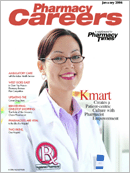Publication
Article
Pharmacy Careers
PHARMACISTS ARE VITAL TO THE LIFE OF A HOSPITAL
Author(s):
THE GROWING COMPLEXITY OF medication therapy and a ?laser? focus on safety have given pharmacists the opportunity to play an increasingly vital role in the hospital setting. At Hackensack University Medical Center (HUMC) in Hackensack, NJ, one is just as likely to find a pharmacist making rounds with a physician as filling a prescription.
"?As physicians realize the extensive amount of knowledge pharmacists have about drug use, we hear more and more that they rely very heavily on pharmacists regarding drug usage, including identifying the appropriate dose and, in some cases, even the appropriate drug for a patient to be on,? said Steven J. Aragona, MS, MBA, RPh, director of pharmacy and clinical services at HUMC.
?We are finding that our physicians increasingly realize the value of pharmacists, and, before we even add a new drug to the formulary, it?s reviewed by one of our clinical pharmacists, who prepares and presents a monograph at the medical center?s Pharmacy and Therapeutics Committee,? said Aragona.
HUMC was just ranked number 42 and number 45, respectively, for heart and heart surgery and geriatrics on US News & World Report?s Best Hospitals 2005 list. Pharmacists are involved on many of the interdisciplinary teams that plan care for such patients, and HUMC physicians find their presence to be a key element of the planning process. On specialty units, physicians benefit from sharing rounds with clinical pharmacists, whom they have described as being walking, talking encyclopedias of drug information. This interaction helps pharmacists experience a more fulfilling and meaningful career path.
The process of pharmacists rounding with physicians at HUMC started back in 1986. About 2 years ago, HUMC began a pilot program in which staff pharmacists were decentralized to specific areas, and the medical center is now in the process of expanding it.
?We are initially trying to select particular areas of the hospital that will benefit most from having a decentralized pharmacist available and looking at our staff to identify those pharmacists who would be a good fit for those areas of interest,? said Aragona. ?We have decided on this approach rather than just picking someone and saying ?you?re going to be the pediatric pharmacist.??
Aragona added that HUMC has not put a deadline on this process, stating that ?we want this to be a quality program, and we want to make sure we carefully match and train our pharmacists in the interest of patient safety.? The training of staff pharmacists is further enhanced by the fact that some of the HUMC clinical pharmacist positions are joint faculty positions with the Rutgers University Ernest Mario School of Pharmacy. The partnership keeps HUMC on the cutting edge of pharmacy education. This arrangement provides an onsite source of education, and it increases the pool of available clinical pharmacists.
Currently, HUMC has clinical pharmacists serving the surgical intensive care unit (ICU), the medical ICU, the critical care unit, pediatrics, neonatology, and the emergency trauma department. Pharmacists with experience in infectious diseases, internal medicine, and anticoagulation also serve the needs of HUMC patients.
Keri Bicking, PharmD, BCPS, BCNSP, is a pharmacist in surgical critical care trained at the Mayo Clinic, where she received advanced training in the ICU. Dr. Bicking said that today, as medicine becomes more specialized, so too does the practice of pharmacy. Most recently, she has been working with what the medical center deems high-alert drugs, and is helping to identify extra precautions that need to be taken concerning availability and utilization guidelines. In fact, HUMC now has increased the involvement of pharmacists in areas most likely to use high-alert medications.
HUMC also employs what is called a rapid-response team (RRT), a group of health care providers called upon when a patient is in distress, but not in a state of emergency. The RRT was initiated this year in the late winter/early spring. Dr. Bicking said that, although there is no pharmacist on the RRT yet, the medical center is currently exploring how a clinical pharmacist can be incorporated into the team.
Another area where pharmacists are integrating their talents is technology. ?One safety measure that has been instituted at HUMC is its computerized physician order entry (CPOE) system,? said Nilesh Desai, RPh, pharmacy operations manager. CPOE eliminates the step in which a pharmacist often has to interpret a handwritten prescription to determine what the doctor has ordered. HUMC is instituting CPOE in a stepwise approach and will build on it as the medical staff gains experience and confidence in using the system.
Currently, HUMC has approximately 80 pharmacists, including about 60 staff pharmacists, 9 clinicians, a director of pharmacy, a pharmacy operations manager, a staff development pharmacist, and a team of pharmacy supervisors. In addition to the main pharmacy, the campus houses 7 satellite pharmacies located in various medical/surgical and ambulatory areas. The medical center also opened a retail pharmacy at the hospital about 6 months ago to expand pharmacy services to patients who have just been discharged from the hospital.
?If you were to see the size of our campus and the number of buildings that need to be covered, the fact that we are able to deliver comprehensive pharmacy services is something we are all very proud of,? said Aragona. ?We are very proud of our pharmacists and our clinical staff. They are an extraordinary group of professionals dedicated to caring for our patients.?
Ms. Whelan is a freelance writer based in Teaneck, NJ.







